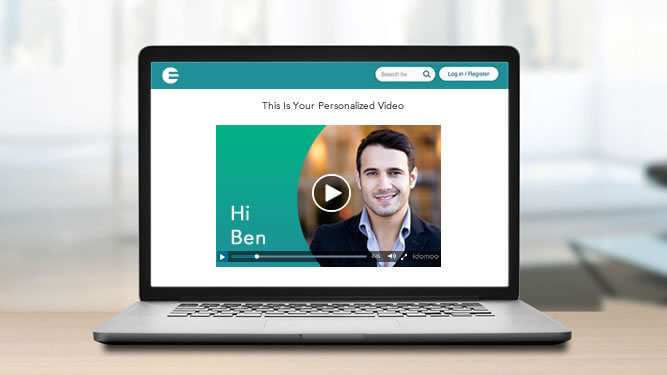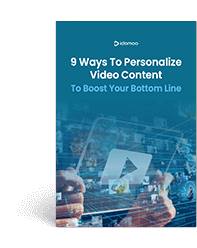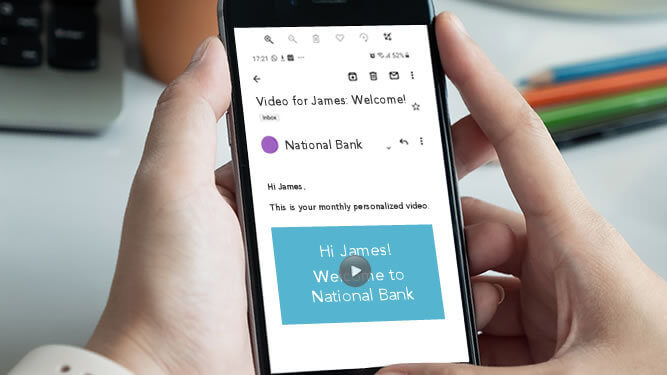Email marketing is a powerful tool. Despite the continued growth and innovation of other channels, email campaigns remain the best way to promote your brand.
Can you embed a video in an email? Yes! And what’s more, you absolutely should. When you embed video in email communications, you can tell stories in a much more compelling way than with text and static images.
Including videos in email is effective because you can grab the reader’s attention quickly and connect with them on an emotional level to build brand awareness, boost engagement, create leads and generate sales.
Not sure how to embed a video in an email campaign? The good news is that it’s pretty straightforward. You don’t need to worry about sending big attachments, and you won’t have to purchase any special software. All you need to do is embed a thumbnail of the video that readers can click to be taken directly to your video landing page.
This guide will cover the importance of video in email marketing, how to develop and incorporate your content and instructions and tips for embedding video in email to increase customer engagement.
Why Use Video in Emails?
There are several reasons to embed video in email. The overall goal may be to increase engagement, generate leads, and convert potential customers into active buyers. However, the best email campaigns aren’t solely sales funnels. They strengthen customer relationships and create trust. Including videos in email marketing helps with all of these aspects in a few important ways.
Helping with understanding: Videos are an easy way for people to gain a thorough understanding of your products and services without having to read several paragraphs of text. This helps with sales, certainly, but also retention. Common use cases are self-serve customer support and onboarding welcome videos.
Adding a personal touch: A video that speaks to the customer directly (quite literally — try greeting your customer by name) makes your email not only more engaging but also personal.
Engagement: Viewers are less likely to click away or close an email that includes video content. Video is far and away the most consumed media type on the internet.
Leads: People are more likely to read the entire email and click on calls-to-action after watching a video. With the latest Living Video technology, you can even add clickable links and elements within your video.
Conversions: Videos can be used to proactively answer consumer questions as they watch, so leads become more confident (i.e., higher quality) and are therefore more likely to convert to sales.
Branding: It’s easier to convey your brand’s personality and core values in a memorable way when you embed video in your email.
Besides all of these compelling reasons, the simple fact is that embedding video in email campaigns works. Take a look at the numbers:
- Viewers retain 95% of a message when they watch it in a video compared to 10% when reading it in text.
- 68% of consumers prefer videos over articles, infographics, ebooks, and presentations when looking for information about new products or services.
- 86% of people would like to see more video content from brands.
- Consumers who end up on an ecommerce site through a user-generated video are 184% more likely to purchase and spend 45% more.
Optimise Your Video Content
Post on
Whether you’re announcing an event, a new product, sending out a newsletter, or simply providing your subscribers with bonus content, videos can play a pivotal role in helping achieve your goals. However, you need to get it right, which means careful planning and strategising to develop suitable videos fit for purpose.
Follow these steps to create the best email video content for your subscribers:
- Identify your goals: Define the purpose of the email campaign and what you are hoping to achieve.
- Define your message: Messages that are too long or too detailed are unlikely to stick in people’s minds. Keep it simple and to the point.
- Select the appropriate video type: Decide what type of video is the best for your intended goals and how you can incorporate it into the flow of your email. There are many video styles to choose from, including:
- Demonstration (demo) videos
- Explainer or how-to videos
- Product promotion videos
- Testimonial videos
- “Behind the scenes” company culture videos
- Know your audience: Make different videos for different segments of your email list to target your communication efforts. For example, if you’re marketing to Gen Z, the newest group to enter the consumer landscape, it pays to keep in mind what will specifically catch their interest. Go one step further and personalise your videos to show your viewers you know them individually and understand what they need.
- Scripting: Use language your audience understands. Choose your words carefully, keep explanations simple, and avoid complicated terminology.
- Keep videos short and snappy: Around 1-2 minutes is a good target length for videos in an email. The goal is to convey precise information with plenty of detail but without losing viewer interest.
- Mailer frequency: Short content shared often is an excellent strategy for sending videos via email, especially for teaser campaigns or newsletters. Sending new video content at regular intervals helps subscribers know when to expect to hear from you and develop a long-term interest in your content.
- Make a video thumbnail: The thumbnail image is the first thing readers will see when they open your email. It needs to make an impact so that people will click play to learn more. You can choose between using a screenshot from your video or creating an animated GIF (more on that later). Either way, it’s essential to overlay a play button on the thumbnail image to get more clicks. Try personalising the thumbnail with your customer’s name to catch their eye.
We love this video from AXA, a multinational insurance company who uses Personalised Video for cross-selling and retention.
As you can see, personalisation went beyond the first name, including the customer’s coverage, their policy expiration date and more. By providing content that was both relevant and valuable, they delighted their customers and offered a complementary coverage option to drive sales.
This kind of approach has proven effective. In their Personalised Video campaigns, AXA has seen up to 8x increase in conversions and a CTR 3x higher than previous email marketing campaigns.
How To Embed Video in Email
Now that your video content and thumbnail has been finalised, it’s time for the final step: learning how to embed video in email campaigns. As we highlighted earlier, this process is not as complex as it may sound. All you need do is embed the thumbnail so subscribers can click it. From there, they will be taken directly to the relevant video landing page.

And this approach is often used for individuals rather than brands. Sending your aunt a video from your latest vacation? Absolutely, attach it to the email. Sending your thousands (or millions) of customers a video via your email marketing software? A video thumbnail is what you want.
Of course, if you’re wondering how to embed a YouTube video in emails, a link will work to direct people to YouTube, but we still recommend a thumbnail to make it more clickable.
These are the steps to follow to properly embed your thumbnail within the main body of your email. This method works equally well for sharing videos from your company’s website or embedding YouTube videos in emails.
- Create a thumbnail that fits the width of your newsletter or email template, including the play button on the image or GIF.
- Insert the thumbnail in your email marketing software as you would any other image.
- Link the thumbnail to your video.
- Add a link to the video landing page somewhere in the email copy as well so recipients have two ways to get the content. This is especially important since there’s always the chance that images won’t display.
Mission complete. You’re done!
Top Tips for Embedding Video in Email
Want to take your email marketing strategy to the next level? We’ll share some tips on how to increase customer engagement and conversions on your campaigns.
Choose the Right Thumbnail
Using the right thumbnail is critical to get those all-important opens and clicks. Here are some best practices for creating a thumbnail that stands out.
- Use a screenshot from your video that is eye-catching or consider a GIF showing part of the video so there’s movement.
- Make your thumbnail high contrast by choosing an image or GIF with bright colours and darker text on the overlay.
- On Personalised Videos, use a thumbnail with the subscriber’s name to encourage them to click play.
- Avoid “clickbait” images. While it may get you more clicks, you’re likely to lose trust and engagement quickly. Instead, use an image that sets realistic expectations about video content.
- Create a thumbnail template for future marketing campaigns — your videos will become readily identifiable as part of your brand.
Use a GIF Instead of a Video
We already mentioned you can use a GIF as the thumbnail in your email for people to click to get their video, but you can also use a GIF in place of the video completely.
Using a GIF gives emails a sense of motion. And it’s just as easy to personalise as an image or video. GIFs are particularly good for lighter use cases where you don’t need a full video. Good examples include wishing a customer a happy birthday or a time-sensitive promotion about a year-end sale.
GIFs are typically only a few seconds long, but they can still make a big impact on the overall quality and CX of your email.
Stand Out With Your Subject Line
Be clear from the start: what will your subscribers get from opening your email and watching your video? We recommend the following to achieve the maximum number of opens and views.
- Use the word “video” in the subject line. This has been proven to increase open rates.
- Ensure the subject line clearly describes what the video is about and the benefits of watching it. What will your subscribers learn? How will it help them?
- Avoid spammy language in your title and subject line that might lower open rates and increase the likelihood of your email being marked as spam.
Video Marketing Success, Guaranteed
Ready to embed video in your email campaigns to increase CTR? As you can see, the challenge lies not so much in knowing how to do it, but in creating valuable, engaging content for every subscriber.
When you partner with Idomoo, you harness the power of Personalised Video to engage, convert and wow your customers — whether that’s via email, in app, on your website or elsewhere in the digital landscape.
Book a call with one of our experts to start your journey into the world of Personalised Video email campaigns.






